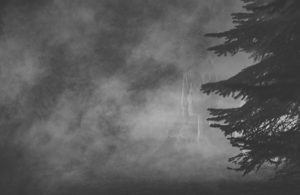
Part III — War on the Shore: Niagara-on-the-Lake
By Ted McIntyre
Occupying a remarkably fortunate quadrant of property on the northwest end of this tourist destination’s historic Old Town, Niagara-on-the-Lake Golf Club was strutting like a peacock as I surveyed its fairways, camera in hand, early last month. Mature Siberian Elms and maples framed its nine fairways and barely a blade of grass seemed out of order. A recent tree removal program has opened up captivating views to the mouth of the Niagara River and Lake Ontario, northward to Toronto, and I figured there could not be a better spot in town for post-round dining than the club’s waterside patio.
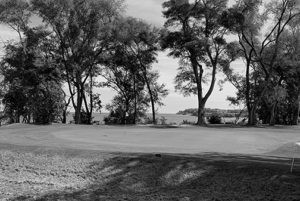
The opening green at Niagara-on-the-Lake GC, with the confluence of Niagara River and Lake Ontario beyond.
As a semi-private nine-hole facility, singles and twosomes are typically paired up to fill the tee sheet, particularly given the record number of rounds this season. Still, it doesn’t feel rushed on this breathless, sun-drenched, end-of-summer afternoon. In fact, there’s almost a Deep South lag to the unstressed pace of golfers making their way around the 145-year-old layout.
Perhaps their general mood is buoyed by the surprising affordability of the experience—$39 for the easily walked nine and $60 for 18 in prime time—given that this Victorian-styled section of Niagara-on-the-Lake annually draws some 3.5 million tourists, many with deep pockets.
While Niagara Falls itself is the main attraction is these parts, the historical significance of Niagara-on-the-Lake is not lost on visitors. And golfers are quickly reminded of its brave and bloody past, with the compact but sturdy Fort Mississauga and its surrounding earthworks a mere wedge shot beyond the first green.
“The oldest golf course in North America on its existing grounds is literally built on top of a battlefield and military camp. And its far west end is pretty much where, during the War of 1812, the American army landed for the invasion of Niagara in 1813,” explains Kyle Upton.
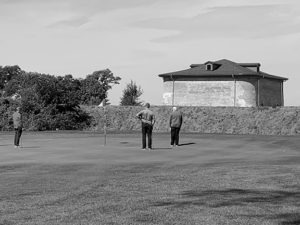
Fort Mississauga, built to replace the wooden Fort George, lies just behind the first green.
As the founder of Ghost Tours of Fort George, Upton’s expertise primarily concerns the dutifully restored fortification that anchors the other end of town, a military post that defended Upper Canada during the American attacks more than 200 years ago. But he is also well versed in the history of Fort Mississauga.
“They started building it in 1814 and finished after the war, replacing the wooden Fort George with a stone fort that was properly located on high ground at the mouth of the Niagara River,” Upton relates.
It’s not known when the spiritual remnants of what took place on these grounds first made their appearance, but the oldest documented account of a paranormal-type occurrence in Niagara-on-the-Lake comes from Andrew Greenhill, a soldier posted at Fort Mississauga early on the morning of June 11 in 1871. The following passage appeared in Greenhill’s journal, reproduced in Canadian Military History, edited by Cameron Pulsifer:
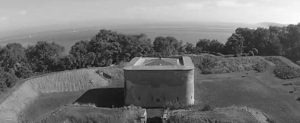 “One of the rooms in the central tower was occupied by the guard. The first two hours off, Jim and I spread our blankets together on the hard oak floor and slept as sound as a top the whole time. We had to turn out at 2 a.m. Jim was put on the gate and I on the ramparts. It was pitch dark and the time dragged wearily along. The only sound that broke the deathlike stillness was the waves washing against the lakefront of the fort. The only things we saw in that long two hours were a dog and a tall figure in a black robe. It glided along the top of the wall swiftly and was seen by Jim as well as myself. My knees shook under me. I fixed my bayonet, gave chase and challenged, but it glided out of sight and left me more frightened than ever. We said nothing to the guard about it after, being afraid of ridicule.”
“One of the rooms in the central tower was occupied by the guard. The first two hours off, Jim and I spread our blankets together on the hard oak floor and slept as sound as a top the whole time. We had to turn out at 2 a.m. Jim was put on the gate and I on the ramparts. It was pitch dark and the time dragged wearily along. The only sound that broke the deathlike stillness was the waves washing against the lakefront of the fort. The only things we saw in that long two hours were a dog and a tall figure in a black robe. It glided along the top of the wall swiftly and was seen by Jim as well as myself. My knees shook under me. I fixed my bayonet, gave chase and challenged, but it glided out of sight and left me more frightened than ever. We said nothing to the guard about it after, being afraid of ridicule.”
LAUGHING IN THE NIGHT
More sinister sightings have been documented since, including those of a headless man and a shirtless, blood-spattered young British soldier roaming outside the fort.
“And there are stories of people saying they were out on the golf course late at night and could hear cannon fire and musket fire and screams of the dying,” shares Niagara-on-the-Lake GC superintendent Mike Magwood. “Although one tends to ask, ‘What exactly were you doing on the golf course late at night…and did you, perhaps, have any bottles with you?’
“But there are stories of weird stuff occurring out on the battlefield,” adds Magwood, who has held the superintendent post since arriving at NOTL in 1997. “A few times when I’ve been out there watering at night, I’ve heard these weird laughs—not a kid’s laugh or something from a party. Often at No. 6 fairway, as though someone is near my side. I’d shine my flashlight around, but there was never anybody there. Sometimes it has sounded more like the crying laugh of a woman—that one kind of made me nervous.”
But Magwood has a better story. “In the past four years, I’ve seen it three times,” he begins. “At dusk, just before it’s completely dark, at No. 7. It was always near the fort, except when he was sitting on the bench at the sixth tee once—this guy, an older man walking hunchbacked, with a raincap, raincoat and rubber boots, like an old seafaring fisherman. I saw him last year. I stopped and did a doubletake and spun around and he was gone. It was unreal. I swung my flashlight toward the bank. We have no trees left there, with the bank erosion and the Parks Canada tree removal project. So there was nowhere to go, and I know he couldn’t have cut in front of me, and he was walking so slowly.
“I’ve never been really afraid,” Magwood contends. “Although seeing that guy lumbering along, and the screeching laugh of that lady…”
It can be a spooky town in general, though. Niagara-on-the-Lake’s most elegant accommodations, the Pillar and Post, has more than its fair share of sightings, notably a girl in a red dress, sheepishly standing in a stairwell just outside the Carriages and Cannery restaurant.
And then there’s Room 222, where the TV suddenly turns on and off, doors slam and items seem to disappear into the ether.
“However, in room 118 there are apparently two wonderful women with English accents who enjoy having guests visit them, and will quite often turn on music for everyone’s entertainment,” writes Denise Ascenzo for Niagara Now. “One such radio with music playing was unplugged by a cleaning woman, who then took the radio to maintenance—all the while the music kept on playing. It is said that staff, after cleaning room 118, tell the ‘ladies’ they can play music until the guests arrive. Some say music plays from the room until the moment a guest opens the door.”
THE OLDE ANGEL INN
 But the town’s most famous incorporeal being is that of Captain Swayze. With United States forces pushing northward through the winter of 1813, British soldiers were ordered to abandon their posts and withdraw. Whether his primary motivation was a sense of duty to a town in the midst of being burned to the ground by turncoat Loyalists, or for the love of a woman (who would never arrive), Swayze ignored orders and stayed behind.
But the town’s most famous incorporeal being is that of Captain Swayze. With United States forces pushing northward through the winter of 1813, British soldiers were ordered to abandon their posts and withdraw. Whether his primary motivation was a sense of duty to a town in the midst of being burned to the ground by turncoat Loyalists, or for the love of a woman (who would never arrive), Swayze ignored orders and stayed behind.
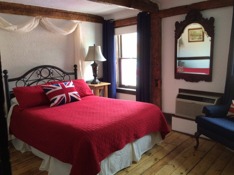 Legend has it that as Niagara-on-the-Lake was invaded, Swayze took refuge in a wine cellar of what is now the basement of the Olde Angel Inn, hiding out in an empty wine barrel. Having seen him enter the inn, American soldiers followed Swayze inside. Sensing he had taken refuge in one of the barrels, they plunged their bayonets into one container after another until the red fluid oozing out was no longer wine.
Legend has it that as Niagara-on-the-Lake was invaded, Swayze took refuge in a wine cellar of what is now the basement of the Olde Angel Inn, hiding out in an empty wine barrel. Having seen him enter the inn, American soldiers followed Swayze inside. Sensing he had taken refuge in one of the barrels, they plunged their bayonets into one container after another until the red fluid oozing out was no longer wine.
“That fish has gotten bigger over the years,” admits Upton. “I originally heard the story from a Mrs. Ledieu, who actually grew up in the place and was the owner from the late 1980s and early ’90s. She said Swayze was a militia officer in the British Army during the battle of Fort George in 1813, did not retreat with the remainder of the British forces and got caught in town and hid in the basement. The American soldiers found him, roughed him up and he died. The vibe from her is that it wasn’t an intentional murder, but that there was too much enthusiasm is capturing him, and he got dead. There was never a reason why he didn’t retreat with the rest of the army. The hiding in the barrel and the ‘sobbing Sophia’ connection of how he stayed to make sure his fiancée was safe—both of those are more modern additions to the story.
“But he has a room associated with him above the inn,” Upton notes. “Guests have reported waking in the middle of the night and an apparition at the foot of the bed—angry if you’re a male, but just fine if you’re a woman.”
But the eeriest place in the Olde Angel—a five-room facility established in 1789, making it Ontario’s oldest operating inn—remains the basement, home of the inn’s washrooms and infamous cellar, where Swayze lost his life and where footsteps and apparitions are regularly reported.
GHOSTS OF FORT GEORGE
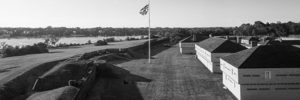
Ghost Tours of Fort George takes visitors onto the grounds of this War of 1812 site, as well as into its tunnel below.
But if you want a guided paranormal experience, there’s always Ghost Tours of Fort George, operated by Friends of Fort George, a charitable organization that works in partnership with Parks Canada to keep local history alive.
“At the fort itself we’ve been really lucky that the ghosts have been very generous with their time and energy,” Upton says. “We had 13 stories to begin with, and didn’t have to look very hard to find others, both from past staff and visitors who’d been there. What we didn’t anticipate, though, was stuff happening on the tour itself.”
Upton is matter-of-fact in his delivery, and quick to dismiss much of what he has seen or the stories he has heard, knowing there is a plausible explanation for most of the occurrences. But not for all of them.
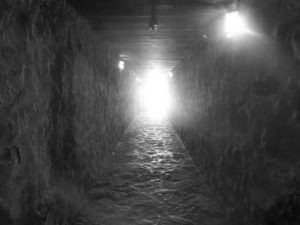 “There have been lots of apparitions, breezes, tugs, pushes, people who were there then not there, tour guides who went from standing up to not standing up,” Upton says. One of his most memorable occurred one stormy summer night. Lightning flashed and thunder rolled, but the rain was holding off for the moment, as Upton led his tour group into the tunnel at the back of the fort, just south of Fort George’s ammunitions building. As he turned back to the entrance, a small girl was looking back. But in a blink of lightning, she was gone—although Upton says her shadow lingered for a few moments.
“There have been lots of apparitions, breezes, tugs, pushes, people who were there then not there, tour guides who went from standing up to not standing up,” Upton says. One of his most memorable occurred one stormy summer night. Lightning flashed and thunder rolled, but the rain was holding off for the moment, as Upton led his tour group into the tunnel at the back of the fort, just south of Fort George’s ammunitions building. As he turned back to the entrance, a small girl was looking back. But in a blink of lightning, she was gone—although Upton says her shadow lingered for a few moments.
He figures it was Sarah Ann Tracy, who passed away in 1840 at age seven. Buried alone in the cemetery of St. Mark’s Anglican Church nearby, curly haired Sarah Ann, daughter of a sergeant major, has reportedly made regular appearances on the grounds, from playing near the officers’ quarters to actually prancing alongside tour guides.
But he had a more personal encounter with another entity at the same location. “It’s 60 feet down that tunnel and, depending upon the lighting circumstances, you can see still slightly outside,” Upton says. “One time I was noticing something near the entrance, a kind of haze. Some others in the group were also seeing it. It’s the only really convenient way out of there, and so we started back and I got to the entrance and the haze was still there. I didn’t want to turn back to the group and say, ‘Hold it a minute, there’s this weird spooky haze here blocking the only way out of the tunnel!’ I decided to step through it and there was definitely this sensation of moving through something. You know how you sometimes get this spike of cold down your spine? This one ran up my spine.”
His most frightening experiences? “That’s when stuff happens violently on tours,” Upton notes. “It hasn’t happened a whole lot. And, happily, when it does, most of the victims have actually seemed excited about the experience—‘Look, bruises! That’s awesome!’ But from the tour guide’s point of view, being responsible for putting people into that circumstance, you sometimes wonder, ‘What if something goes terribly wrong? At what point is it not worth the risk?’ I mean, there are very few places I would call more home than Fort George. I love the place. In the day, the night, whenever. I have the sense that I’ll keep coming back. But there are some nights when the atmosphere is just off; when it’s like, ‘Now it’s time to get out of here,’ and I’m not comfortable going back and locking up.
“But I do keep going back.”
Check out all five parts in this ghostly series:
Part I: Legends of the Abbey
Part II: The Algonquin Resort
Part III: War on the Shore: Niagara-on-the-Lake
Part IV: Spirits of the West: The Banff Springs and Jasper Park Lodge
Part V: Ghost Town, B.C.: Victoria and the Spirit of Doris Gravlin





2 Comments
Leave your reply.